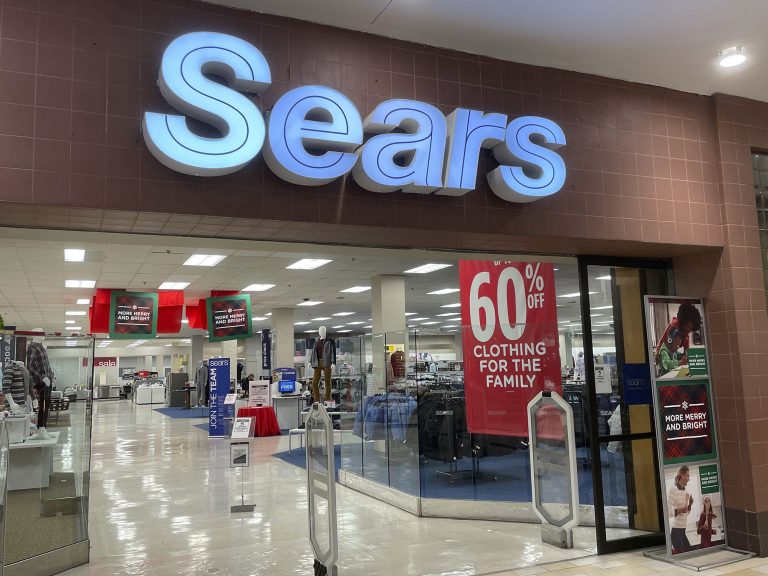The best lessons don’t come from successes but from failures. We have been working on collecting stories of companies that went bankrupt despite being a big player in their industry. Our eBook will be out soon and you can pre-book it here. In this article, we discover the various factors that led to Sears’ Bankruptcy and what innovation leaders can learn from it.
When Sears Roebuck was in colours
Sears also known as Sears Roebuck and Company was founded in 1893 and was headquartered in Hoffman Estates, Illinois. It is a chain of department stores that provides retail services to its customers.
Sears was once famous as a leading retailer, offering a wide range of products through its iconic catalogues and retail stores. It was a pioneer in the retail industry and was known for its innovation and customer satisfaction. In 1945, Sears reached $1 billion in sales.
During 1969, Sears was so dominant that its sales represented 1% of the total US economy, with two-thirds of all Americans shopping there. Despite all of this, things didn’t remain well for the company. There are a few major reasons why Sears failed. Let’s learn about them.
Revealing Sears failure case study
Changing Hard Road to the Softer Side
Sears was renowned for its DieHard, Craftsman, and Kenmore brands that targeted mostly men for home-building products. In the 1980s, Sears attempted to target female shoppers to boost sales.
Under CEO Arthur Martinez, the company launched “The Softer Side of Sears” ad campaign in 1993 to draw more women and back-to-school shoppers. However, the clothes in Sears stores clashed with the washing machines and treadmills it was attempting to promote.
It only made the merchandise more confusing for many customers. The ad campaign was seen internally as an early sign that Sears was heading on the wrong track.
It also diversified its operation, adding on insurance, banking, investments, and real estate. Sears’s CEO Martinez blamed that diversification for losing focus in his book, “The Hard Road to the Softer Side: Lessons from the Transformation of Sears.” He added, “We had made embarrassing mistakes.”
Bad investments by the CEO
The fate of every company depends largely on how the leadership thinks. We have seen how bad leadership decisions resulted in the downfall of Commodore or Polaroid failure. Sears CEO diversified the company’s target audience which disrupted the company’s overall customer base.
The next mistake of the business leaders was – implementing a bad financial strategy which acted as fuel in the fire of Sears’s Bankruptcy.
While other stores had invested heavily in their operations, Sears had implemented drastic cost-cutting strategies. According to a Susquehanna Financial Group report, Sears spent approximately 91 cents per square foot in 2017 to make enhancements online and in stores, while J.C. Penney spent $4.13, Kohl’s spent $8.12, and Best Buy spent $15.36.
As Sears’ stores deteriorated further, they were unable to produce enough revenue to pay for their upgrades, creating a negative investment cycle that resulted in declining sales and less money available for investment in the future.
Too much bad experimentation
Talking of the mistakes of Sears management, one of them was merging with Kmart. In 2004 Sears merged with Kmart, a deep discount retailer. This was a mistake for the Sears brand since it confused its value proposition.
Sears maintained a distinct position in the retail market at the time. Their brand was a one-of-a-kind balance of quality and price. Sears cheapened their brand by merging with Kmart, putting them in direct competition with discount retailers such as Walmart and Target.
After Sears and Kmart merged, the holding firm had over 3,500 stores. And what happened to Sears after that? Well, there are currently fewer than 900 of them, many of which are located inside malls that are already having trouble attracting foot traffic as more and more people buy online.
Sears CEO Lampert cut off a significant number of stores for cash when he spun out 250 of its finest properties into a real estate investment trust, Seritage, in 2015. As a result, Sears was faced with the challenging job of reversing its fortunes using only the assistance of its weakest stores.
The constant need to sell more properties and other assets to pay off debt has in many ways accelerated Sears’s failure. Lampert most recently suggested Sears sell additional real estate worth $1.5 billion as its final attempt to raise money to keep the company alive as a significant loan payment was approaching. Edward Jones analyst Matt Kopsky said,
“Sears has sold most of its top real estate over the past ten years and its remaining properties may not be worth much. I don’t see a scenario where this improves by [Sears] waiting.”
They were no longer innovating
The company did not really experience a lack of innovation. Sears was innovative. In the early 1980s, as computer technology advanced and the internet took shape, Sears launched Prodigy, a cutting-edge, consumer-driven commercial online service. It also prioritized selling some of its products online before launching Sears.com in 1999.
So Why has Sears failed?
Despite adopting technological innovation, Sears failed to innovate its psychology. Much of Sears’ troubles over the last two decades can be traced back to the company’s unwillingness to adopt the mindset of a modern, digitally-driven enterprise.
According to Craig Johnson, president of retail research and consulting firm Customer Growth Partners,
“There are generations of people who grew up on Sears and now it’s not relevant. When you are in the retail business, it’s all about newness. But Sears stopped innovating.”
Sears discontinued its legendary catalogue in 1993. The catalogue played a significant role in both Sears’ business strategy and American society generally for the majority of the 20th century. The catalogue was essential to the company’s extremely prosperous mail-order operation in its early years. There were two reasons why this mail-order company was significant.
First, it made it possible for rural customers to order goods through the postal service, greatly expanding their client base.
Second, at a period when few businesses could use big data for their retail strategies, the catalogue gave Sears exclusive customer information. Despite the catalogue’s sentimental value to many of its customers, Sears abandoned the initiative in the 1990s after it had been decades of unprofitability.
Learnings from Sears’ Bankruptcy:
Sears, once a retail powerhouse, faced numerous challenges in the face of intense competition from discount chains and the rise of e-commerce. The company failed to adapt to changing consumer shopping habits, struggled with financial instability, and filed for bankruptcy in 2018. At that time, the company had $11.3 billion in liabilities.
Sears’ major failure was a lack of innovation. Sears lost its competitive edge and their advantage in advertising and customer data without a replacement for their catalogue. As a consequence, Sears collapsed.
Of course, no one can predict what will happen when. But, if Sears had made better business decisions, captured more innovative ideas from its employees, and stayed put with changing market trends, it might still be thriving in business.
Implementing an idea innovation management tool lets innovation managers capture innovative ideas from the entire organization.



